Most people understand the importance of boiling water when the time comes to purify it of dangerous germs. This is especially imperative in all sorts of wilderness survival situations, but equally as important if your local water service has been disrupted or damaged.
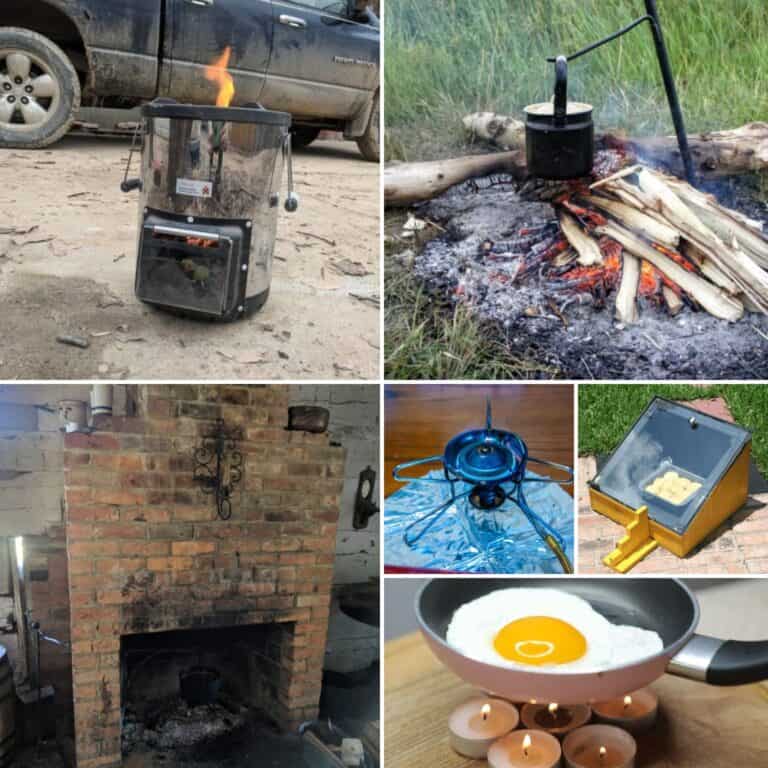
And sure, boiling water is a piece of cake as long as you’re at home, have a stovetop and electricity or gas to operate it. But things get a lot more challenging when your stove is out of commission for whatever reason.
You don’t have to worry, though, if you know some alternate ways to boil water. I’ll show you 12 stove-free ways to do that below.
1. Fireplace
Boiling water using a fireplace is a traditional, effective and reliable indoor method, especially when one doesn’t have access to a kitchen stovetop.
It provides a substantial amount of heat, more than capable of boiling water efficiently. However, this method requires practice to ensure safety and efficiency if you aren’t used to cooking over open flames.
For instance, botching the placement of the pot or use of long-handled tools might cause accidents.
Furthermore, regular maintenance of the chimney is essential to prevent smoke and carbon monoxide buildup, which can be harmful or deadly.
CO buildup is the very last thing you can afford to deal with when you’re already in the middle of a survival situation!
If you have a fireplace in your home that has been collecting dust, you should look into getting it tuned up and inspected because it can be a huge resource in the aftermath of any disaster.
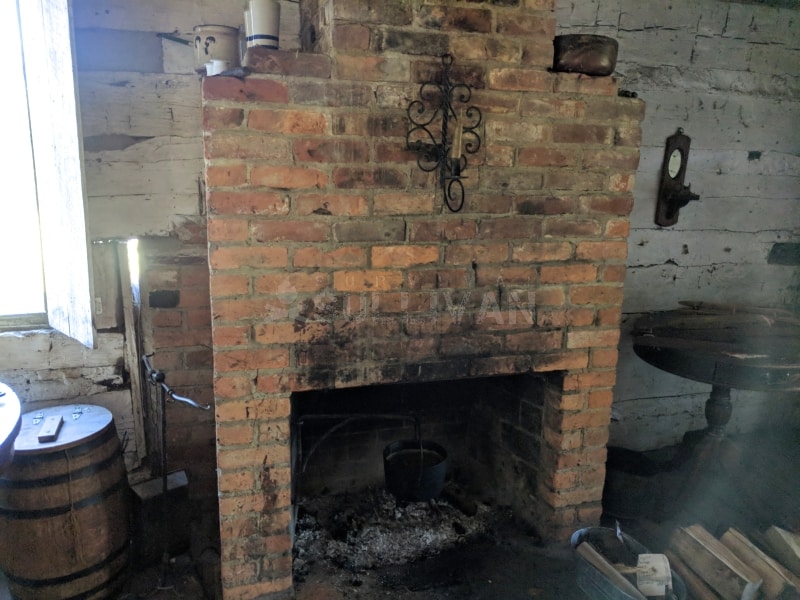
2. Woodstove
A woodstove is another excellent indoor alternative for boiling water without a stovetop. Not only is it highly effective, but it’s also generally safer than using a fireplace.
Many woodstoves come with cooktops designed for this purpose, making the process even more straightforward.
You can very literally get a fire going in your wood stove and then just set a pot of water on top if it has a cooktop until it comes to a roiling boil. But if you don’t have a pot, please check out this article on how to boil water without a pot for other suited solutions.
But just like fireplaces, woodstoves require regular maintenance to ensure they function safely and efficiently.
Cleaning out ash and soot, checking for leaks, and inspecting the stovepipe and chimney are all necessary to keep your woodstove in top condition and keep your living quarters safe.
If you live in a colder region, or just one with rough winters, the right wood stove could be a perfect way to keep warm and ensure you’ll always be able to boil water in a pinch.
3. Campfire
A campfire is an obvious outdoor method for boiling water that offers true flexibility and the comfort of knowing you can boil water anywhere.
A campfire can be built anywhere it’s safe to do so, and if you are in a real jam you can burn multiple types of fuel, including wood, charcoal, or even paper and cardboard.
However, boiling water on a campfire does require a bit of extra preparation, and it’s a skill you’ll need to practice if you want to do it safely and reliably.
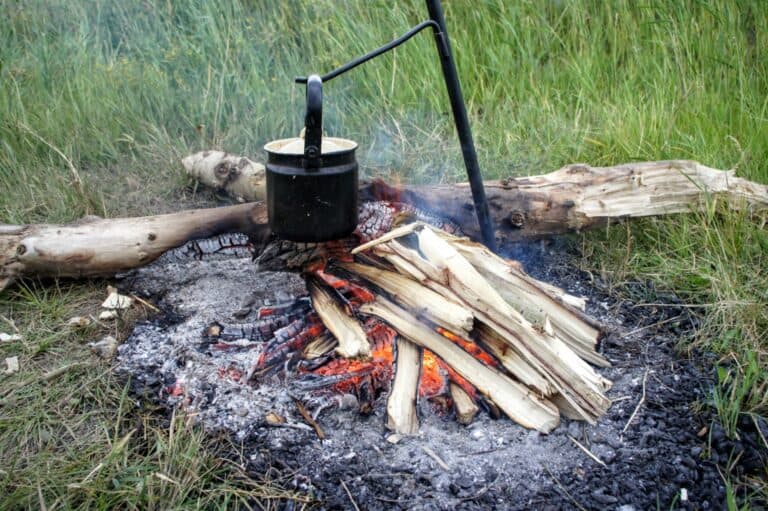
You’ll also need to balance the pan or pot over the flames, which might require additional materials like rocks or a grill grate to achieve. Materials that should be in no short supply, sure, but not always!
Despite its basic prepper appeal and versatility, a campfire is not the most efficient way to boil water due to massive heat loss to the open air.
You’ll be using a lot more fuel than you have to in order to boil water, so it is most efficient if you are already using the fire for warmth, light or cooking…
4. Rocket Stove
For those seeking a super-efficient method of boiling water at home or in the field, a rocket stove is an excellent choice.
These stoves can be crafted from natural materials as nothing more than a hole in the ground with a couple of angled intake holes in a pinch, or used as a standalone cooking appliance and there are many made for portable and semi-portable use.
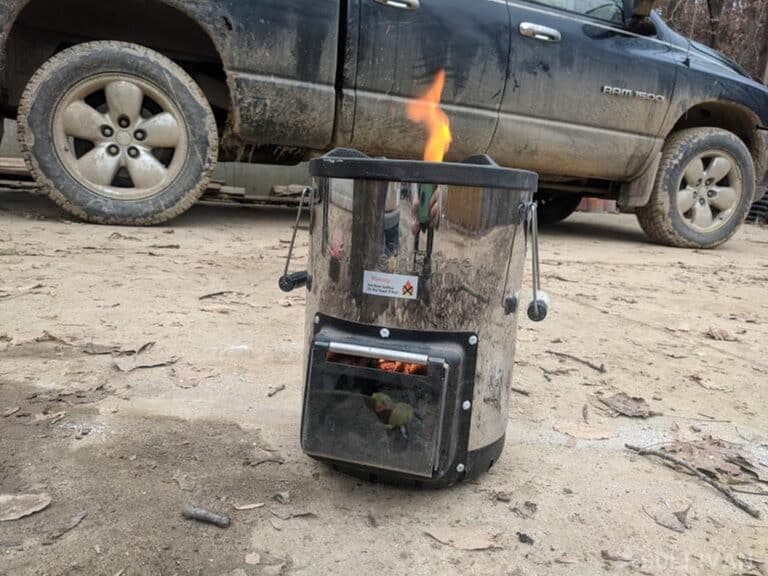
a functioning rocket stove
Rightly renowned for their super-efficient fuel use, rocket stoves can bring water to a boil very quickly and do so using dramatically less fuel than a campfire or fireplace, and also while admitting very little smoke and other combustion byproducts.
However, they are slightly more intricate to set up compared to a simple campfire. The design and implementation of a field rocket stove requires careful attention to ensure proper airflow and maximum heat generation.
But once mastered, a rocket stove is a highly effective and fuel-efficient alternative for boiling water whether you’re bugging in or bugging out.
5. Solar Oven
Believe it or not, you can use the power of the sun alone to boil water. Well, the power of the sun in conjunction with a solar oven!
A solar oven is a safe and cost-effective solution, one that can be used anywhere there’s clear sky and abundant sunshine. Some ovens can also be packed down small, making them a great option for camping or outdoor activities.
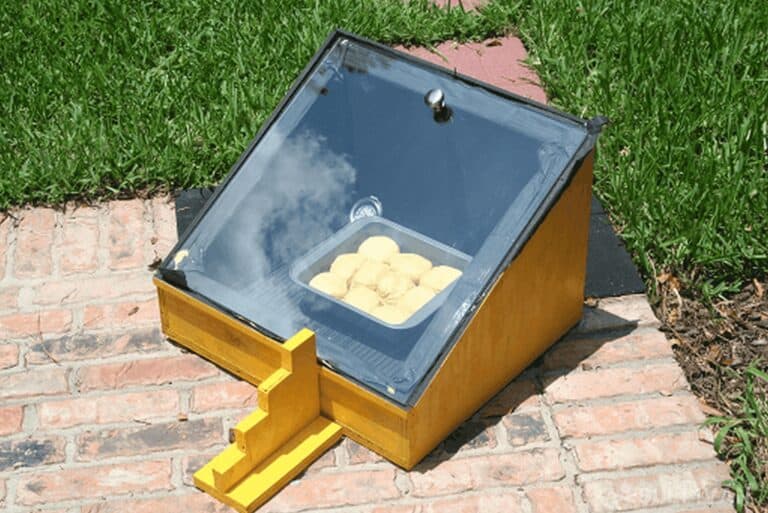
small DIY solar oven with tray of cookies baking inside
However, this method does have its downsides… It’s often not super quick unless you are boiling a small quantity of water in ideal conditions, and boiling water must be done during daylight hours for obvious reasons.
Moreover, effectiveness is significantly reduced on cloudy or overcast days, enough that you might not be able to boil water at all, although a highly efficient and maintained solar oven could still pull it off.
Regardless, solar ovens are a great ace in the hole when it comes to boiling water, and are must-have capability if you live in an area with a very high annual UV index.
6. Hot Plate
I know it sounds like cheating, but a hot plate is distinct from a stove, you know. A hot plate offers a convenient and quick way to boil water, working well in any location with counter space.
This makes it a great choice for those living in small apartments or dormitories, or for those who need a semi-portable solution for in-home use.
[TAG5]
However, hot plates do require a substantial amount of electricity to function, which means they’re only going to be viable if you still have electrical service wherever you are, or if you’re making your own with a generator or other personal electrical infrastructure tech.
But, assuming you can take care of those few requirements, a hot plate will definitely take care of it.
7. Tea Lights
Tea lights are tiny candles, often used for ambiance or warming snacks, and area highly portable and adaptable method for boiling water, especially when power is out.
Although not the most efficient use of candles, they can be good in a pinch and are best used indoors due to their small size and lower heat output.
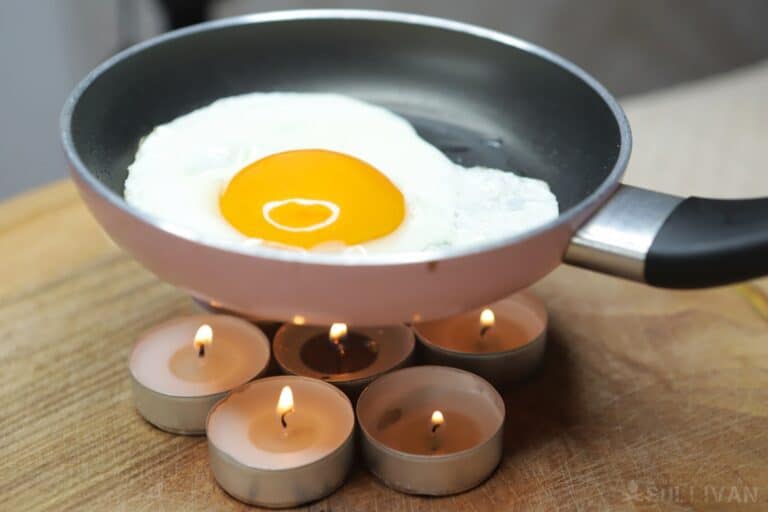
cooking an egg over tealights
The process can be slow as tea lights don’t produce a lot of heat, but with patience and careful arrangement, they can certainly be used to boil a smaller quantity of water in a reasonable amount of time.
8. Camp Stove
A camp stove is another highly portable option that offers a faster way to boil water compared to tea lights.
However, this method does require a dedicated fuel source such as propane or butane, though there are some that are designed to use twigs or biofuel.
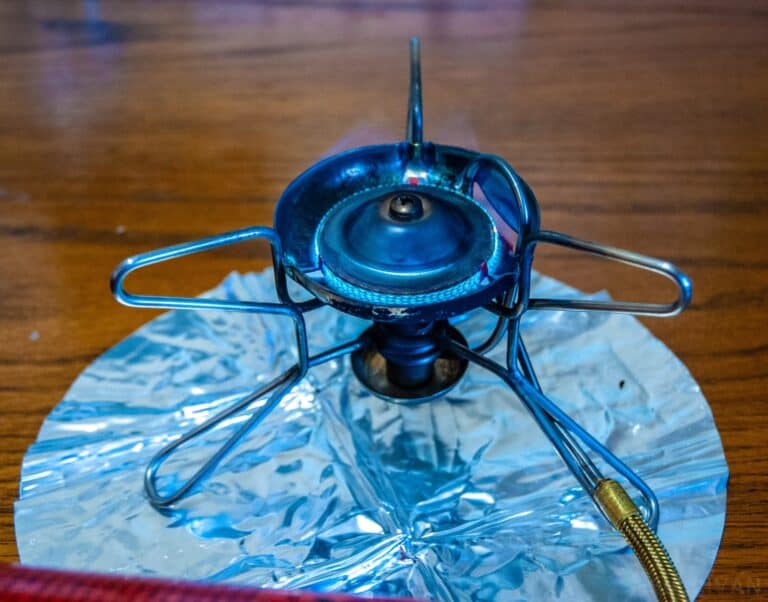
a functioning MSR Whisperlite camp stove
While it’s quick and effective, a camp stove is typically only suitable for small containers, limiting the amount of water you can boil at once.
While they can be used indoors, it must be done with caution to prevent carbon monoxide poisoning or fire hazards, and it’s generally recommended to use them in well-ventilated areas or outdoors.
Still, they are a reliable and easy-to-use option in a pinch, and are good for far more than just hiking and camping.
9. Hot Rocks
The hot rock method is an ancient and versatile way to boil water while camping, especially in outdoor survival scenarios. This involves heating rocks over a flame and then dropping them into a sturdy container of water to rapidly bring it to a boil.
While this method is indisputably fast and effective, it does come with its own unique challenges.
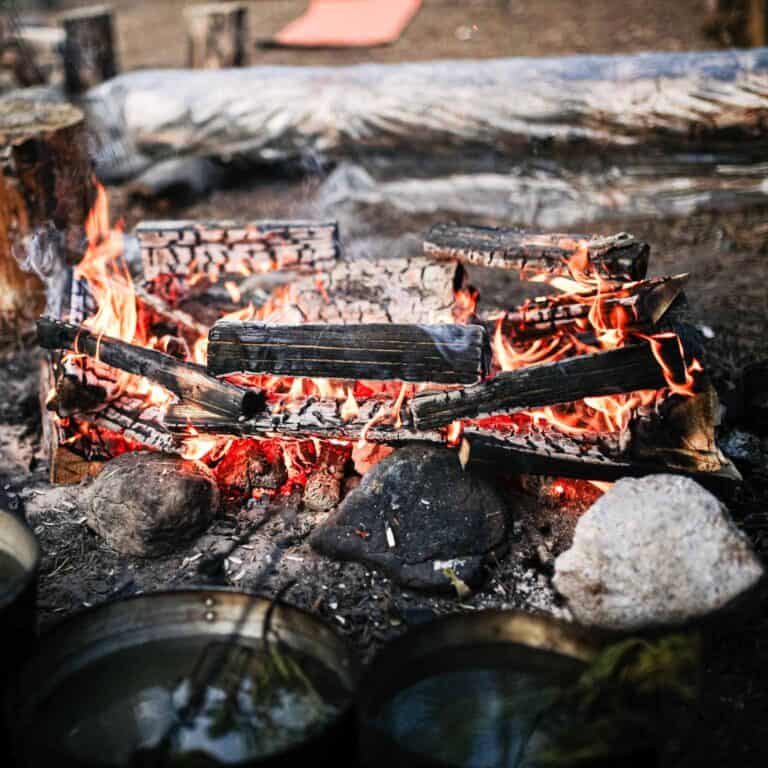
Handling heated rocks can be highly perilous due to the risk of severe burns, and heating damp rocks can make them explode into dangerous shrapnel!
Also, the addition of rocks makes the water container much heavier in the meantime, and displacement of now-boiling water is also an issue to consider, as adding rocks will cause water levels to rise. The risk of burns is not something to take lightly!
10. Grill
A grill, particularly a charcoal one, offers a convenient and easy-to-use method for boiling collected or tap water in times of trouble. Charcoal grills are versatile, able to use various fuel sources including charcoal, wood, or even biomass briquettes.
They can boil water quickly, especially when run very hot, but this tends to be inefficient due to high fuel consumption. One major limitation of grills is that they’re not usable indoors due to CO and potential fire hazards, meaning they’re an outdoor-only option.
And of course, you can certainly use a propane grill for the same purpose if that’s what you have. Any sturdy steel cookware that is safe on your stove top should be safe on your grill. Just watch out for plastic parts!
11. Sterno (with Modifications)
Sterno cans, commonly used for catering or camping, are not typically hot enough to boil water on their own. But with some clever modifications or especially designed stove for the purpose, they can be made to do so.
One way is by placing multiple Sterno cans inside a specially designed “inferno” stove, which helps concentrate the heat from the cans, and thus make your water boil.
Another improvised and borderline-unsafe modification involves wrapping the Sterno can or cans with an aluminum foil “chimney” to trap and channel the heat.
Despite these modifications, making Sterno cans a viable method for boiling water, there are still significant drawbacks.
Sterno cans can be relatively expensive and heavier than you might expect for their size, meaning they are a big weight investment for a short-lived option when afield.
They can be used indoors and outdoors (depending on the type), but as with any open flame, caution should be exercised to prevent terrible accidents.
12. Microwave
Of course, we can’t forget about that trusty kitchen standby, the microwave! Boiling water in a microwave takes only a minute, perhaps more, as long as you can provide power and have a microwave-safe container for the water, preferably a glass one.
Your microwave can boil a smaller quantity of water in just about 60 seconds and a larger quantity in a couple of minutes, making it a wonderful option when you need to purify that water in a hurry.
But, obviously, microwaves need tons of power and are not really portable for surviving outdoors. Nonetheless, don’t forget about them if you still have electricity.
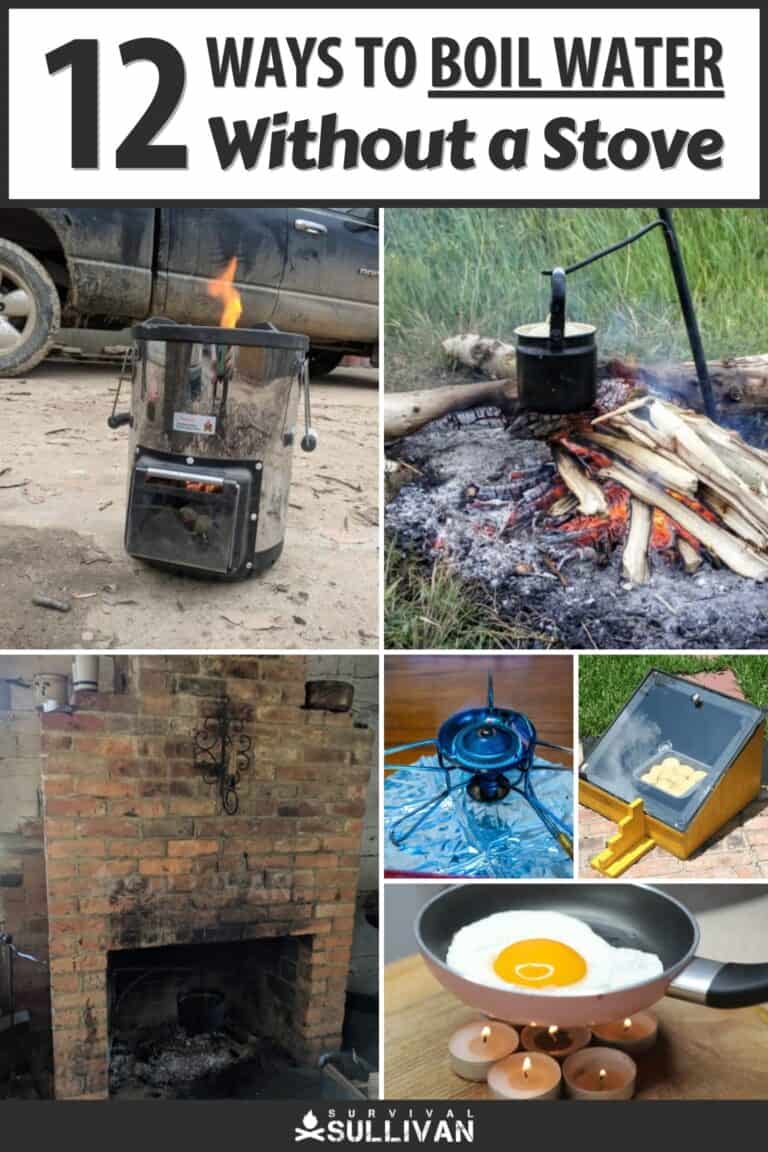
The post 12 Ways to Boil Water Without a Stove appeared first on Survival Sullivan.
By: Tom Marlowe
Title: 12 Ways to Boil Water Without a Stove
Sourced From: www.survivalsullivan.com/how-to-boil-water-without-a-stove/
Published Date: Thu, 21 Sep 2023 16:00:00 +0000
------------------------
Did you miss our previous article...
https://bushcrafttips.com/bushcraft-news/mil-spec-overland-comforts-of-an-rv-on-an-lmtv
 What is BushcraftSurvival SkillsToolsVideosBushcraft CampsBushcraft KitsBushcraft ProjectsPrivacy PolicyTerms And Conditions
What is BushcraftSurvival SkillsToolsVideosBushcraft CampsBushcraft KitsBushcraft ProjectsPrivacy PolicyTerms And Conditions
